Waikiki Get Down - Honolulu, Hawaii
News Item- Powered by MBC NewsMaker
Two Honolulu Zoo Society Educators Selected As Semi-Finalists In Wildlife TV Program's Webisode Contest
- Tweet

TWO HONOLULU ZOO SOCIETY EDUCATORS SELECTED AS SEMI-FINALISTS IN WILDLIFE TV PROGRAM'S WEBISODE CONTEST
Two Honolulu Zoo Society educators have been selected as semi-finalists in a video contest to become the next "Wild Guide" for Mutual of Omaha's Wild Kingdom. Stephanie Arne and Charles Lee each have the opportunity to win $10,000 and host the award-winning wildlife TV show's new webisode series, premiering this fall on YouTube.
A panel of judges selected 12 semi-finalists from nearly 200 entrants, giving each video submission a score out of 75 points. Now it's up to the public to help choose the top three finalists. Individuals can help Arne and Lee in winning the "Wild Guide" title by voting for one video once a day now through May 23 at www.wildkingdom.com/nextwildguide.
The top three finalists with the highest combined judging and voting scores will each receive $5,000 and fly to Omaha, Nebraska, this June for an audition. The winning "Wild Guide" will be announced on July 15.
Arne and Lee's video submissions can be viewed at http://wildkingdom.com/nextwildguide.
The four-time Emmy award-winning Wild Kingdom remains one of the most respected wildlife programs since its network television premier on January 6, 1963. Mutual of Omaha seeks to entertain its modern-day viewers with the launch of its "Wild Guide" webisode series, featuring fun, adventurous entertainment tailored for today's audience.
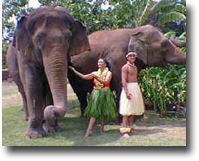 ABOUT HONOLULU ZOO
ABOUT HONOLULU ZOOOver 600,000 people visit the Honolulu Zoo annually. The zoo is administered by the City & County of Honolulu through the Department of Enterprise Services. The Honolulu Zoo Society provides fundraising and educational services for the zoo.
It is the largest zoo within a radius of 2,300 miles and unique in that it is the only zoo in the United States originating from a King's grant of royal lands to the people. King David Kalakaua, Monarch of Hawai`i from 1874 to 1891, made lands of the Leahi Land Holdings available in 1876 to the people for a thirty year lease. That year, a "Kapiolani Park Association" of two hundred subscriber members assumed the administration of the three hundred-acre park. The marshy parcel was a muddle of fishponds, lagoons and islands where King Kalakaua maintained his collection of exotic birds. In 1877 the area was named after the King's wife and opened as Queen Kapiolani Park.
HONOLULU ZOO MISSION STATEMENT (Back to the top)
The mission of the Honolulu Zoo is to inspire the stewardship of our living world by providing meaningful experiences to our guests. The Zoo emphasizes Pacific Tropical ecosystems and our traditional values of malama (caring) and ho'okipa (hospitality).
HOURS (Back to the top)
9:00 am to 4:30 pm daily
Closed Christmas Day
MAP Back to the top
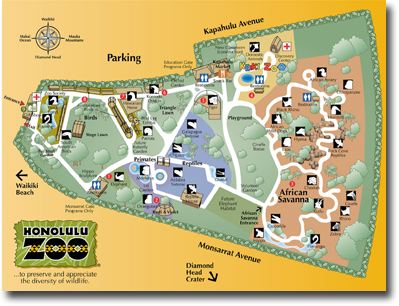
MEMBERSHIP
Founded in 1969 as the Zoo Hui, the Honolulu Zoo Society of today is governed by a volunteer Board of Directors and employs a permanent staff. Membership consists of people representing families and individuals from across the State of Hawaii and the continental U.S. More....
VOLUNTEER PROGRAM (Back to the top)
If you care about animals and the environment and have the desire to get involved, here is some information about how you can join our Zooper volunteer team! More...
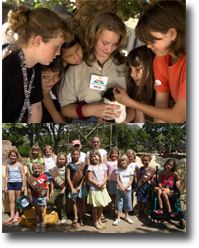 ACTIVITIES & PROGRAM (Back to the top)
ACTIVITIES & PROGRAM (Back to the top)School Group Programs:
- School Outreach - Zoo To You
- School Groups - Zoo Field Trips
- Art in the Zoo
- Dinner Safari
- Star Gazing at the Zoo
- Vacation Adventures
- PreVacation Adventures
- Honolulu Zoo Strollers
- Birthday Parties
- Snooze in the Zoo
- Twilight Tour
- Junior Zoo Keeper
- Keiki Zoo Keeper
- Breakfast with a Keeper
- Volunteer Program
- Interpretive Services
Click here to get more info on activities and programs on Honolulu Zoo website.
FAMILY PROGRAM REGISTRATION FORM Back to the top
HISTORY OF HONOLULU ZOO (Back to the top)
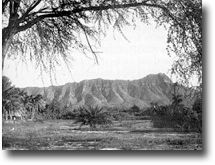 Around 600,000 people visit the Honolulu Zoo annually. It is the largest zoo within a radius of 2,300 miles and unique in that it is the only zoo in the United States originating from a King's grant of royal lands to the people. King David Kalakaua, Monarch of Hawai`i from 1874 to 1891, made lands of the Leahi Land Holdings available in 1876 to the people for a thirty year lease. That year, a "Kapiolani Park Association" of two hundred subscriber members assumed the administration of the three hundred-acre park. The marshy parcel was a muddle of fishponds, lagoons and islands where King Kalakaua maintained his collection of exotic birds. In 1877 the area was named after the King's wife and opened as Queen Kapiolani Park.
Around 600,000 people visit the Honolulu Zoo annually. It is the largest zoo within a radius of 2,300 miles and unique in that it is the only zoo in the United States originating from a King's grant of royal lands to the people. King David Kalakaua, Monarch of Hawai`i from 1874 to 1891, made lands of the Leahi Land Holdings available in 1876 to the people for a thirty year lease. That year, a "Kapiolani Park Association" of two hundred subscriber members assumed the administration of the three hundred-acre park. The marshy parcel was a muddle of fishponds, lagoons and islands where King Kalakaua maintained his collection of exotic birds. In 1877 the area was named after the King's wife and opened as Queen Kapiolani Park.Park Association members supported the unpromising park with the help of royal grants through 1894. In those days, the park's primary attractions were the exotic bird collection and horse racing, especially the running of the Rosita Cup, held annually on King Kamehameha Day.
Peacocks, trees, and palms were added to the park, with plantings obtained from Golden Gate Park in San Francisco. Roads and trolley lines were extended to include "Waikiki Road at Makee", today's intersection of Kalakaua and Kapahulu Avenues. The park was permanently established in 1896 and the City and County of Honolulu assumed administration of city parks in 1914. Today, the zoo continues under the administration of the City, but as a part of the Department of Enterprise Services.
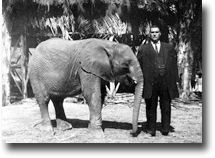 During 1914 to 1916, the young administrator of Parks and Recreation, Ben Hollinger began collecting animals for exhibit at Kapiolani Park. The first animals included a monkey, a honey bear and some lion cubs. In 1916 Daisy, a friendly African elephant arrived in Honolulu on the Niagra, a steamship on it's way from Australia to Canada transporting animals for mainland zoos and circuses. Ben Hollinger, pictured at left with Daisy, persuaded city merchants to purchase Daisy and for years she delighted Honolulu children. Many recall riding as a youngster around the park on her back.
During 1914 to 1916, the young administrator of Parks and Recreation, Ben Hollinger began collecting animals for exhibit at Kapiolani Park. The first animals included a monkey, a honey bear and some lion cubs. In 1916 Daisy, a friendly African elephant arrived in Honolulu on the Niagra, a steamship on it's way from Australia to Canada transporting animals for mainland zoos and circuses. Ben Hollinger, pictured at left with Daisy, persuaded city merchants to purchase Daisy and for years she delighted Honolulu children. Many recall riding as a youngster around the park on her back.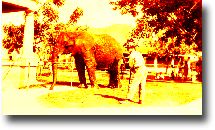 Daisy's career ended tragically in 1933, when for unexplained reasons, she attacked and trampled to death her keeper George Conradt. She was put down by police marksmen and buried at sea. Pictured right are Daisy and her keeper George Conradt. (See recent newspaper account.)
Daisy's career ended tragically in 1933, when for unexplained reasons, she attacked and trampled to death her keeper George Conradt. She was put down by police marksmen and buried at sea. Pictured right are Daisy and her keeper George Conradt. (See recent newspaper account.)During the Depression years, the Zoo faltered and nearly closed. Additional animals still came to the zoo, including the following animals purchased from an animal dealer to arrive November 29, 1949 aboard the freighter, the American Wholesaler, out of Los Angeles: a giraffe, an ostrich, emus, an elephant, a Bactrian camel, 3 sea lions, several other bird species birds, spider monkeys and a tortoise. However, the grounds and facilities continued to fall into disrepair. In 1947, the donation of a camel, elephant, chimpanzees and deer by the Dairymen's Association sparked a renewal for the Honolulu Zoo. During this time the City took important steps to set the course for today's Zoo. It approved a Master Plan that determined the boundaries of the present 42-acre site at the north end of Kapiolani Park. It hired its first full-time director, Paul Breese, and a staff of thirteen. The animal collection, increased by purchase, trade and donations, was housed in newly constructed facilities, some of which still provide foundations for newer exhibits. In 1952 the Zoo's design was revised, and again modified to take on the shape and form seen in the "old zoo" exhibits like the small mammal row along Kapahulu Avenue.
WIKIPEDIA INFORMATION
It is the only zoo in the United States to be established by grants made by a sovereign monarch. Built on part of a 300 acres (121 ha) royal park in Waikiki known as Queen Kapiolani Park, the Honolulu Zoo now features over 1,230 animals in specially designed habitats.
Over 601,510 people visit the zoo annually. The Honolulu Zoo Society provides fundraising and educational services for the zoo. The zoo is administered by the City & County of Honolulu through the Department of Enterprise Services.
Source: Wikipedia, the free encyclopedia
Questions? Ready for an appointment?
- RELATED LINKS

 Honolulu Zoo Society - Waikiki, Hawaii
Honolulu Zoo Society - Waikiki, Hawaii
Our mission is to foster an appreciation of our living world by supporting and advocating environmental education, recreation, biological study and conservation activities at the Honolulu Zoo. More...
 Honolulu Zoo - Waikiki, Hawaii
Honolulu Zoo - Waikiki, Hawaii
View video!. Over 600,000 people visit the Honolulu Zoo annually. The Honolulu Zoo Society provides fundraising and educational services for the zoo. The zoo is administered by the City & County of Honolulu through the Department of Enterprise Services. More...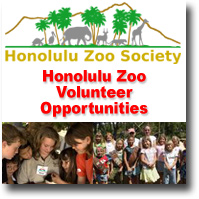
Honolulu Zoo Society Volunteer Opportunities - Waikiki, Hawaii
Volunteering at the Honolulu Zoo is a great way to learn about animals, support a beloved community and have a wonderful time with fellow animal lovers!
 Waikiki, Hawaii Featured Pages
Waikiki, Hawaii Featured Pages
View our directory of feature pages showcasing all the great things Waikiki has to offer. About Waikiki - Honolulu Hawaii
About Waikiki - Honolulu Hawaii
Learn about Waikiki, Hawaii. About Waikiki Get Down.com
About Waikiki Get Down.com
Learn about WaikikiGetDown.com website and its creator. Feature Sponsors
Feature Sponsors
Great offers from our sponsors who support the Waikiki, Hawaii Community More... Waikiki, Hawaii Coupons & Discounts
Waikiki, Hawaii Coupons & Discounts
Save money in Waikiki, Hawaii with these coupons.
Terms of Use / Legal Disclaimer / Privacy Statement
Site Designed and Managed by MacBusiness Consulting
